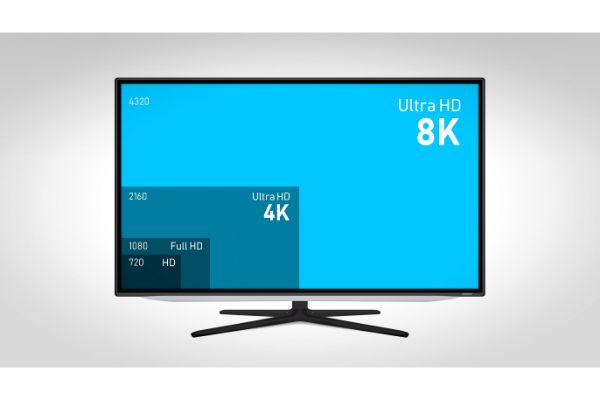Disclaimer: This post may contain affiliate links, meaning we get a small commission if you make a purchase through our links, at no cost to you. For more information, please visit our Disclaimer Page.
HD+ stands for High Definition Plus, a video resolution between regular HD and full HD. The precise resolution of an HD+ monitor is 1600×900, which looks better than regular HD but worse than full HD. Since most apps aren’t optimized to use this resolution, it’s pretty rare on computers.
Table of Contents
Is HD Plus 1080p?
Companies that manufacture laptops and computer monitors often market 1366×768 monitors as HD. Since 1920×1080 (1080p) monitors are another common resolution, it’s not unusual for a non-techie to think HD+ refers to 1080p.
While that theory would make sense, it’s unfortunately not the case. In reality, HD Plus refers to a less common resolution between regular HD and 1080p used for computer monitors. Since 1080p measures 1,920 pixels across and 1,080 pixels down, it’s superior to HD+’s 1600×900.
It’s easy to notice the difference between a monitor with HD+ resolution and a 1080p monitor. Images and text will probably look crisper on the 1080p monitor, while the HD+ monitor will look somewhat fuzzy.
Depending on what software and operating system you’re running, your computer might default your HD+ monitor to regular HD. To learn all there is to know about the different kinds of HD; you should understand the different monitor resolutions.
What Does HD+ Stand for?
The full meaning of HD+ is High Definition Plus, which is a general term for monitors with a 1600×900 resolution. They’re not as common as regular HD or full HD monitors that have since taken the world by storm.
You’ll likely see HD, full HD, and quad HD in a list of video resolutions, but HD+ is usually nonexistent. The reason why it’s less popular than most other resolutions is that industry leaders make no monitors in the resolution.
The few monitors available in this resolution usually default back to the old 1366×768 during normal use. Unfortunately, this lowers the picture quality, forcing the monitor to display video in a resolution lower than its maximum potential.
Is HD+ the Same as Full HD?
Look through any list of monitors, and you’ll see a jump from HD to full HD. If you just started hearing about HD+, you’ll be convinced that it’s the same as FHD, but you’d be wrong. HD+ is too unpopular to make it to any official list of monitor resolutions.
To be clear, HD+ refers to a 1600×900 resolution, while full HD is 1920×1080. Even while both of these resolutions are an improvement over regular HD, you only get to full HD at 1080p.
For clarity, full HD is the same as 1080p resolution. Since I’ve already clarified that HD+ isn’t the same as 1080p, repeating it in this section feels redundant. To avoid this redundancy in the future, the following section will explore different HD resolutions on the market.
What are the Different HD Resolutions Available?
At this point, it’s justifiable to be convinced that every video resolution is a variation of HD. With HD+ differing from HD, Quad HD, and Full HD, there are just so many HDs to explore. Nonetheless, what are the different HD resolutions available for computer monitors?
Here are some of the different HD resolutions available for computers:
High Definition (Regular HD)
When HD monitors were introduced in 1998, they became very popular, as they were better than the existing SD resolution. While the regular standard definition monitor measured 640 pixels across and 480 pixels down, HD smashed that with 1280×720.
Fast forward to 2022, regular HD monitors are almost completely nonexistent. Most people wouldn’t even know of the existence of HD if it wasn’t an option for watching videos on YouTube. As a result, nobody buys HD monitors anymore, and manufacturers don’t care to include them in their products.
However, a particular segment of the market demand budget computers with cheap components. Since the regular 1280×720 resolution was impractical, manufacturers started including a different variation of HD without changing the name.
Today, a regular HD monitor is more likely to be 1366×768 than the original resolution. In addition, this new resolution is sharper than the original HD, allowing cheap monitors to support up-to-date operating systems and apps.
High Definition Plus (HD+)
HD+ is almost exclusive to expensive Lenovo laptops at some point. Before the advent of full HD, Lenovo wanted something more premium than HD, and that thought birthed HD+. However, the idea of HD+ didn’t age well, as it’s now less popular than the regular HD resolution itself.
HD+ measures 1,600 pixels across and 900 pixels down, creating a wide 16:9 monitor. After most operating systems and graphics cards didn’t update to support this resolution, HD+ monitors started to default to HD.
Full HD (FHD)
Most laptops and monitors on the market today use the full HD resolution, which is 1920×1080 at 16:9. This resolution and aspect ratio is perfect for most operating systems and apps, making it failsafe.
It’s still very popular since you don’t need insanely powerful graphics cards to run a computer at full HD resolution. So if you’re getting a budget laptop in 2022, the chances are high that it’s running on full HD resolution.
While full HD isn’t the best you can get at the moment, it’s the most cost-effective option. If you don’t want your computer cutting your screen when you stream content or play videos, go for full HD.
Quad HD (QHD)
If you’re buying a monitor for gaming or creative work, full HD might not be sufficient. However, having as many pixels as you can get will make your job a lot easier and your images crisper. So if that’s all you crave, look no further than QHD, which is a popular option for gamers and creative professionals.
QHD packs the unique 2560×1440 resolution, popularly referred to as 1440p. While 1440p sounds close to 1080p, the difference between these two monitor resolutions is way more obvious. A 1440p monitor has almost twice the number of pixels as an FHD monitor, and yes, it’s twice sharper.
2k is another slightly lesser resolution than QHD but still superior to full HD. Coming at 2048×1080, it strikes the perfect balance between full HD and Quad HD at a lower price.
You shouldn’t need a quad HD monitor if you primarily use your computer for basic tasks like document editing. However, if you can afford the monitor to make your experience smoother, why not?
Ultra HD (UHD)
Ultra HD monitors are crazily expensive and deservedly so. Also referred to as 4k, UHD is the limit of display technology that a regular graphics card can handle passably. While 8k monitors are slowly creeping into the monitor scene, good luck getting a game to work on those.
4k monitors are popular on costly laptops and computers for professionals that need extra resolution. Measuring 3840×2160, it’s about what you’ll get with four quad HD monitors arranged in a quadrant.
Buying an ultra HD monitor in 2022 isn’t worthwhile for the average consumer. However, the average UHD monitor should be okay unless you’re a movie producer trying to ensure that every detail is perfect.
Full Ultra HD (FUHD)
Full UHD or 8k resolution is only available for individuals trying to push monitor technologies to their absolute limits. At the moment, it’s almost impossible to imagine a scenario where an 8k monitor will make your task easier.
8k monitors have a resolution of 7680×4320, which is also equivalent to arranging four ultra HD monitors in a quadrant. Unfortunately, full ultra HD monitors are almost nonexistent, and the only target demographic are filmmakers that shoot at 8k.
When watching a movie on an 8k monitor, it’s impossible to tell it apart from watching it on a 4k monitor. Unless you’re zooming into the individual pixels, your eyes aren’t good enough to see 7,000 different pixels.
To understand how superior 8k is, you’ll need 16 full HD monitors side by side to recreate 8k. Interestingly, you’ll need up to 64 regular HD monitors arranged accordingly to simulate the pixel count of an 8k monitor.
References
https://support.lenovo.com/ng/en/solutions/ht104457-what-do-hd-hd-and-fhd-mean


